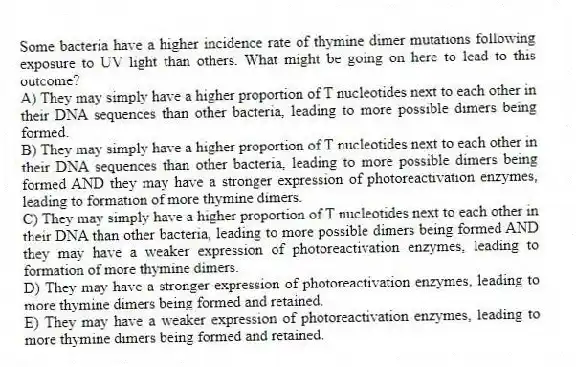
Some bacteria have a higher incidence rate of thymine dimer mutations following exposure to UV light than others. What might be going on here to lead to this outcome?
A) They may simply have a higher proportion of T nucleotides next to each other in their DNA sequences than other bacteria, leading to more possible dimers being formed.
B) They may simply have a higher proportion of T nucleotides next to each other in their DNA sequences than other bacteria, leading to more possible dimers being formed AND they may have a stronger expression of photoreactivation enzymes, leading to formation of more thymine dimers.
C) They may simply have a higher proportion of T nucleotides next to each other in their DNA than other bacteria, leading to more possible dimers being formed AND they may have a weaker expression of photoreactivation enzymes, leading to formation of more thymine dimers.
D) They may have a stronger expression of photoreactivation enzymes, leading to more thymine dimers being formed and retained.
E) They may have a weaker expression of photoreactivation enzymes, leading to more thymine dimers being formed and retained.
Correct Answer:
Verified
Q55: The Ames test determines antibiotic sensitivity of
Q56: Every 24 hours, every genome in every
Q57: Is it as effective to take two
Q58: Which is True about a crown gall
Q59: Two bacterial genes are transduced simultaneously. What
Q61: Which of the following statements about spontaneous
Q62: A patient comes to see you complaining
Q63: A patient comes to see you complaining
Q64: A mutation in E. coli results in
Q65: In order for insertional inactivation to occur,
Unlock this Answer For Free Now!
View this answer and more for free by performing one of the following actions

Scan the QR code to install the App and get 2 free unlocks

Unlock quizzes for free by uploading documents